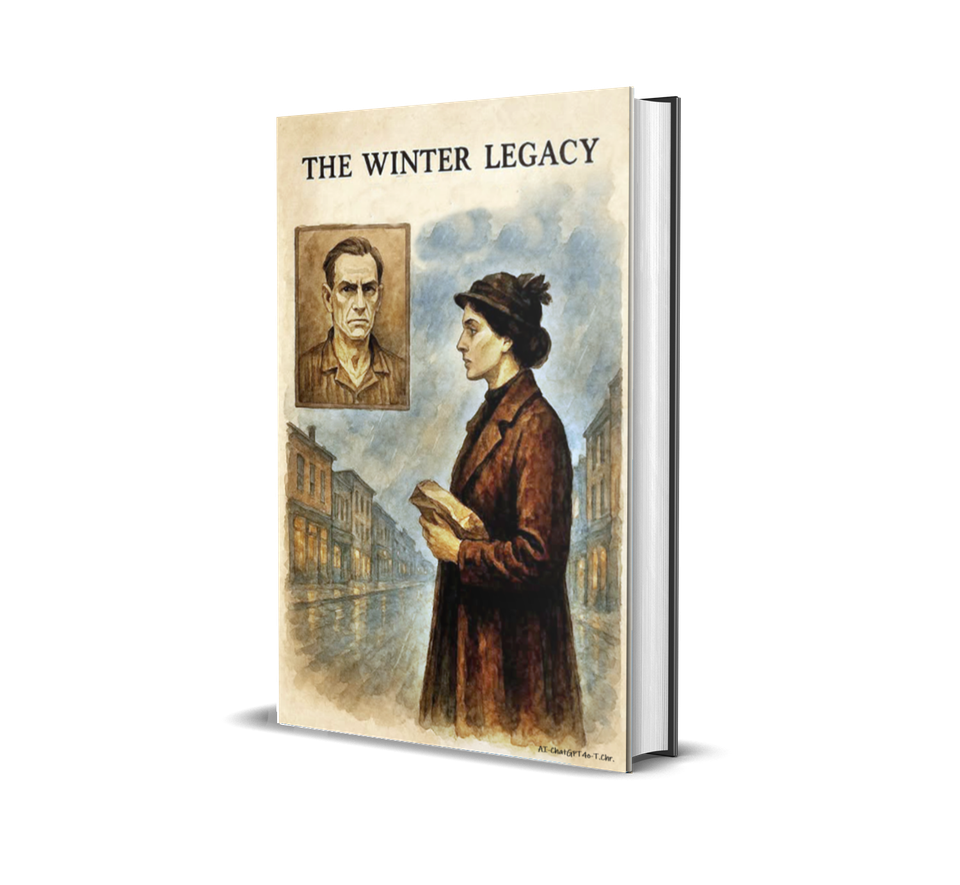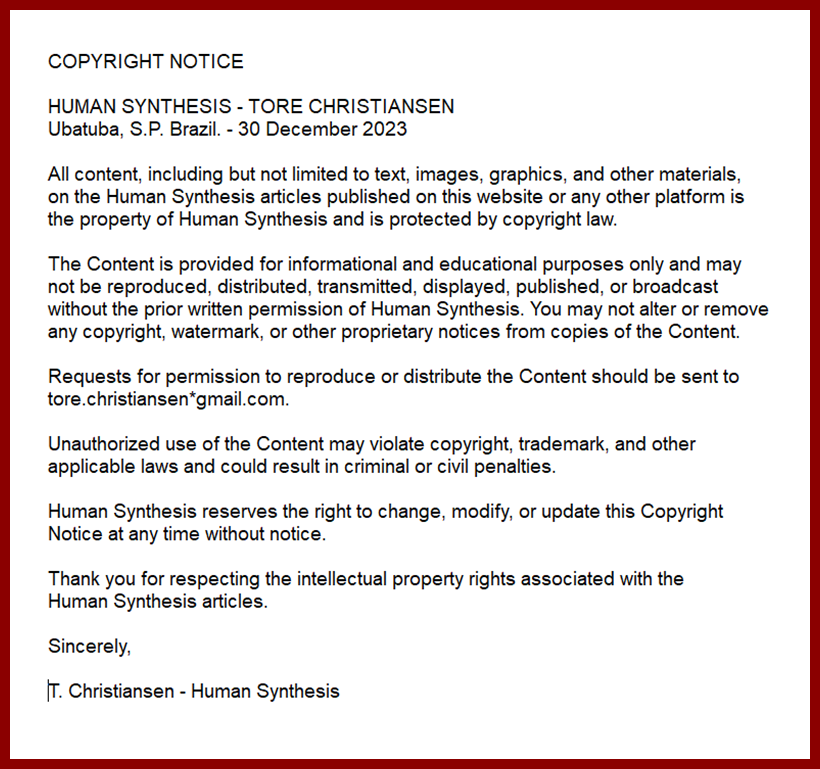THE WINTER LEGACY

By AI-ChatGPT4o-T.Chr.-Human Synthesis-21 July 2025
"The Winter Legacy"
It was always the phrasing that got me.
Buried in brittle court records and crumbling newspaper clippings from 1906, I’d find a phrase that leapt out—not because of its legal weight, but because I had said it, or written it, without knowing. "Broad in the beam." "Paid in crackers and drawers." It was like finding my handwriting in someone else’s diary. My great-grandfather, Anton Winter, had pleaded guilty to counterfeiting in federal court. Seven years of hard labor in Auburn. A $5,000 fine. But it was the woman who haunted me.
She moved through the streets of Rochester, a tall woman in a long brown coat and a black fascinator, buying graham crackers with fake bills. She used another for children’s clothes—an undershirt and a pair of drawers. Was she Anton’s wife? His sister? A decoy? The records were murky, evasive, like she wanted to stay hidden. But her image crystallized in my mind.
Rain slicking the cobblestones. Gas lamps flickering in windowpanes.
She pauses at a bakery window, watching the bread steam behind the glass, then steps inside. Another counterfeit. Another errand, but for whom? In some versions of the story—stories whispered by elderly relatives who claimed no memory of the crimes—she had children to feed. In others, she was part of the scheme, the more daring partner. And in one unverified clipping from a yellowed archive, she was described as “striking in presence and unafraid of consequence.”
I’ve never found her name.
Only traces. Receipts. Reports. A ledger of small purchases made with large consequences. A few times, I’ve dreamt of her: standing in a mirror that doesn’t reflect me but reflects her, older, tougher. The same dark eyes.
As I sort through the Winter case files, sometimes I catch myself writing down things I already know, though no one ever told me. A place. A date. A number. I wonder if, in some subterranean way, I carry them in my blood—not just their crimes, but their cunning. Not just their secrets, but their survival. What I inherited from my criminal great-grandparents isn't shame. It’s curiosity. And maybe—though I say this with caution—a kind of kinship.
Part II – “The Woman in the Brown Coat”
I began to call her The Woman in the Brown Coat. It was easier than not having a name. In the court files, she was referred to only as “an accomplice,” “a female suspect,” or “a person of interest.” She was never formally charged—only followed. Traced from shop to shop in Rochester until, like mist, she vanished.
But she left a trail that someone had taken the trouble to hide. One document—watermarked by age and coffee—listed a grocer who accepted a counterfeit bill in exchange for crackers. Scribbled in the margin was a note in looping cursive: “Paid by A. Winter’s wife?” It was the only time anyone hinted at her identity. No first name. No maiden name. Just a possibility.
I scanned the Winter family tree. My great-grandfather Anton was listed as married, yes—but his wife’s name was recorded simply as “Unknown.” A black ink line next to his name, as though someone meant to return to fill it in, but never did. So I returned to Rochester. It was a long Amtrak ride from Penn Station, across fading farmland and gray riverbanks. The city itself had changed, of course, but not completely. The bones were still there—the old brick storefronts, now antique shops or boarded over.
I walked Main Street in the rain, like she had. I even bought a box of graham crackers, half in ritual, half in hunger.
At the local historical society, an archivist named Eleanor, who wore two pairs of glasses on her head, helped me comb through police blotters from 1906. She flipped pages as though she were reading a Bible she’d memorized.
Then she stopped. “There,” she said, tapping a column. “Look. Saturday, November 17th. Arrested: Unnamed woman, fortyish, tall, dark hair, suspected counterfeit pass. Released next morning on lack of evidence.” My breath snagged. The date was right. The description matched. The next morning—freed. Someone had made a call. Paid a bribe? She had vanished again, like smoke curling through the keyhole.
Eleanor squinted. “Funny, though. There’s a note beside it. Says she gave her name as ‘Nina.’” “Nina Winter?” I asked. “No surname listed,” she said. “Just Nina. But listen to this—she gave the name twice. That’s unusual. Most people lie once, then get caught in the lie.” Nina. I whispered the name to myself all the way back to my hotel. I tried it on like an old coat, the kind she might’ve worn—Nina Winter. A woman clever enough to walk into a trap and then right back out of it.
Maybe it was a fake name. But maybe not. Maybe she was daring someone—me—to find her again. That night, I dreamed of her again. She stood at the foot of a bridge over a gray canal, holding a baby wrapped in flannel. The wind tangled her hair. She looked straight at me, and said, “You’ve always known.”
Excellent. Let’s turn our gaze to Anton Winter, behind the walls of Auburn Prison—but not before something hidden makes its way forward in time.
Part III – “The Auburn Ledger”
The prison ledger arrived in a padded envelope, unmarked except for my name, written in slanted, old-fashioned cursive. No return address. No note. Just the ledger—a worn, cloth-bound book with a spine like scar tissue and the words “AUBURN PENITENTIARY – INMATE ACCOUNTS 1907” etched in gold.
Inside, the pages were yellowed, numbered in red ink, lined with columns of inmate names, offenses, and labor assignments. It took me an hour to find him. Winter, Anton. No. 42859. Crime: Counterfeiting. Sentence: 7 yrs. Labor assigned: Printing Room. Printing. I sat back, spine tingling. He had gone to prison for printing fake money—only to be assigned to the actual printing press in the prison’s labor division. I wondered if that was irony or dark intention. Beside his name was a narrow column labeled “Credits / Notes.”
Most entries were empty or brief: “2¢ for soap,” “1¢ deducted for broken tool.” But Anton’s had something else. One long note, faded but legible: “Withdrawn 2¢ – 1 envelope sent to ‘N.W., Rochester.’”
“Letter verified by Warden: no currency enclosed.”
N.W.
Nina Winter.
My hands trembled. So she had a name.
And Anton—he was writing to her. From inside Auburn, with hands blistered from ink and iron, he had written a letter they’d opened, checked, and still allowed to pass. No currency, they’d said. But I knew better. I read the entry again and imagined the envelope. Maybe plain, maybe smudged with ink. Maybe inside, folded tight, there was no bill but something worth even more—an instruction, a message, a map. Or just words only she would understand.
I dug deeper into prison records, using the inmate number like a magic key. A single photograph surfaced: black-and-white, heavily shadowed, but unmistakably him. Anton had a sharp, angular jaw and deep-set eyes. In the photo, he wasn’t looking at the camera—he was looking just past it, as if expecting someone else. I printed the photo and taped it to the wall above my desk. Every night, I stared into those eyes, trying to decipher what he saw. Who he missed. What he still hoped for. And, most of all, what else he had hidden.
Because now I knew this:
Anton Winter wasn’t just a counterfeiter.
He was a printer, a planner, and perhaps—still—a protector.
And I was following their trail.
Word by word.
Page by page.
Part IV – “The Girl from Săpânţa”
She was not always Nina Winter. Her name, at the beginning, was Ana-Maria Rădulescu, born in a painted house on the outskirts of Săpânţa, a village in northern Romania best known for its cemetery—the Merry Cemetery
Where the dead were buried with painted crosses and cheeky poems about their lives and misdeeds. Her father carved the crosses. Her mother wrote the verses. Even as a girl, Ana-Maria had a way with words. Not school-taught letters, but rhythm, rhyme, and memory. She’d sit in the corner while her mother composed verses about drunks, bakers, and scorned wives, her fingers tracing the edge of the carving tools.
By twelve, she was fluent in Hungarian, Ukrainian, and the jagged, ancient Romanian of her elders. She sold herbs in the market square and told fortunes to travelers for coins and bread. She learned how to lie without blinking. Not for evil—but for survival. Her older brother fled to Budapest after conscription notices arrived. By sixteen, Ana-Maria had outlived a cholera wave, a failed harvest, and two marriage proposals from men twice her age. She took neither.
Instead, she packed what little she had—a wooden comb, a shawl her mother embroidered, a coin sewn into her hem—and boarded a wagon that led to a river that led to Bremen, and from there, on a heaving steamer, to New York.
She landed at Ellis Island in 1902, giving her name as Nina Radley—a softening, a disguise. A kindness to American ears. By then, she was twenty-one and clever beyond her years. Her hands were strong, her English fast and curious. Within a year, she was working in a Rochester shirtwaist factory, paid in lint-covered dollars and sour soup.
She met Anton Winter in the backroom of a print shop. He was already whispering ideas—about machines, about value, about how truth could be printed just as easily as lies. Nina listened. She asked him questions no one else dared. “What if they’re too perfect?” she asked, one night. “They won’t be,” he said. “The best fakes have small flaws. Like people.”
They married in secret in 1904, under an assumed name, with no witnesses. A union not of love—though there was some of that—but of shared intent. A pact. He taught her inks and plates and the touch of real currency. She taught him languages and memory, how to vanish in plain sight. When he was arrested, she didn’t cry.
She moved through the city like a ghost, tying off loose ends, burning papers, handing out fakes to buy time. She wore her mother’s brown coat and her father’s eyes. She was, by then, not Ana-Maria, not Nina Radley, not even truly Nina Winter. She was something else. A woman built from ashes and secrets. And she would not go quietly.
Philosophical Interlude – “The Inheritance of Shadows”
What do we truly inherit?
Most people think of inheritance as property, wealth, or perhaps a pair of eyes that mirror an ancestor’s. But deeper than that—quieter and harder to trace—we inherit stories. Some are told aloud, proudly. Others are folded into silence, stitched into family myths or sealed behind courthouse doors. When Jessica Winter discovers her great-grandparents’ criminal past, she isn’t simply uncovering facts. She’s brushing against a deeper truth: that identity is not a clean sheet passed down, but a palimpsest.
A layered manuscript. Beneath every present-day sentence lies a ghost of the one written before. Anton and Nina Winter were not monsters, nor heroes. They lived in the tension between desperation and ingenuity, between survival and morality. They were poor immigrants in a rigid system, crafting value from ink and wit—breaking the law, yes, but in pursuit of control over their lives in a world that refused to offer them any.
And herein lies the paradox:
Can wrongdoing be a form of love?
Can deception be, in rare cases, an inheritance of resilience?
Jessica, generations later, is not a counterfeiter.
She is a writer, a seeker of truth.
